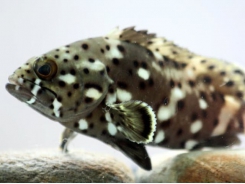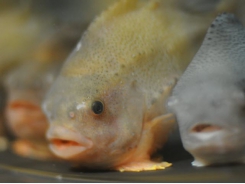Fusarium mycotoxins continue to be the main threat to Southeast Asian aquaculture

In the recent issue of the World Mycotoxin Journal, Biomin experts, led by Rui A Gonçalves, reveal the most recent conclusions of their survey study on plant-based meals and finished feeds in SE Asian aquaculture.
Figure 1 Fusarium verticillioides colony. F. verticillioides is well known for its capacity to produce DON and FUM.
The authors acknowledge that the awareness of mycotoxin-related issues in aquaculture industry is growing, as manufacturers and producers realize the importance of mycotoxins, beyond aflatoxin, and their potential to impact production. However, there are still some erroneous concepts in the aquaculture industry and because of that is so important to identify the industry doubts and correctly address them.
Wrong concepts or misinformation?
One of the main concepts deeply entrenched across the aquaculture sector is that the majority of mycotoxin issues are the result of poor storage conditions leading to aflatoxin contamination. Consequently this wrong assumption brings consequences when the aqua sector professionals seek solutions for mycotoxin management as adsorption, the most common approach to deal with aflatoxins, is not a feasible strategy to tackle Fusarium mycotoxins. However, it remains true that poor storage conditions can lead to the growth of Aspergillus spp. and Penicillium spp., which can ultimately lead to the production of aflatoxins and ochratoxin A, the present observations show that most of the mycotoxins found in finished feeds come from raw materials used to produce feeds.
Mycotoxin contamination in previous years
In previous assessments of mycotoxin contamination in the aquaculture sector (Gonçalves et al. 2016 and 2017), we found that in SE Asian samples, soybean meal, wheat, wheat bran, maize, corn gluten meal, rapeseed/canola meal and rice bran were mostly contaminated with Fusarium mycotoxins (ZEN, DON and FUM). The only exception was cottonseed meal which was mainly contaminated by AF together with other Fusarium toxins (ZEN and DON) in considerable amounts. Finished feed samples were also mainly contaminated by Fusarium mycotoxins, reflecting the use of plant meals.
Processing conditions does not affect mycotoxins
The fact of observing relative high occurrence levels of Fusarium mycotoxins in the feeds, confirms that mycotoxin contamination found in these finished feeds is mostly related to the plant-based raw materials used in their formulation since Fusarium fungi are generally an issue in the field rather than in storage. This reinforces the reminder that mycotoxins commonly occurring in plant stuffs are not destroyed during most processing operations. On the contrary, processing affects mycotoxins distribution and concentrates mycotoxins into fractions that are commonly used as animal feed (plant by-products; eg corn gluten meal, DDGS, etc). The fate of mycotoxins in feedstuffs is variable and affected by several factors such as the type of mycotoxins, the level and extent of fungal contamination, and the complexity of the cereal processing technology. As a result, the use of mould inhibitors does not guarantee that feed is free of mycotoxins, as they are also produce in crops and not destroyed during processing, however, will avoid the production of storage mycotoxins (eg AF, OTA).
Biomin objectives for 2016 Aqua samples
As the contamination of aquafeeds and plant-based feedstuffs with mycotoxins (for aquaculture use) is, in general, often neglected. At Biomin we are interested in fulfill this gaps in order to understand how to better manage the mycotoxin risk in aquaculture. Therefore, the objective of published work was to analyse the risk of mycotoxin contamination in conventional plant ingredients used for aquafeeds (as done in the past). However, also analysing the by-products of these commodities, which are starting to be used in aquafeeds due to their better price and availability, was also conducted. Particular attention was also given to local non-conventional meals and aquaculture by-products (eg shrimp head meals, sun dried fishmeal, etc). Beside the most common mycotoxins (AF, ZEN, FUM and DON) we enlarged our goal to analyse 18 mycotoxins per sample in order to understand the occurrence of masked and alternative metabolites of mycotoxins in these aquaculture feedstuffs. Additionally, finished feeds for fish and shrimp were also analysed. Due to the increasing globalisation of trade, and the incorporation of imported raw materials into aquafeeds, the mycotoxin contamination of locally produced commodities was compared to the same imported commodities.
What we found during 2016?
During the period of one year (January 2016 - December 2016), 175 samples of different plant proteins, aquaculture/fishery by-products and finished aquaculture feeds, were analysed. Samples were tested for: aflatoxins (AF; AFB1, AFB2, AFG1 and AFG2); zearalenone (ZEA); Type B trichothecenes (deoxynivalenol (DON); Nivalenol (NIV); 3-Acetyldeoxynivalenol (3-AcDON); 15-Acetyldeoxynivalenol (15-AcDON) and fusarenon X-glucoside (FUX)); fumonisins (FB; FB1, FB2 and FB3); Type A trichothecenes (T-2; HT-2; Diacetoxyscirpenol (DAS) and neosolaniol (NEO)) and ochratoxin A (OTA). All samples were sourced in Southeast Asia.
Within the analysed samples, only 4 percent were free from detectable mycotoxins. Eight percent of the samples had one mycotoxin and 88 percent of the samples were contaminated with more than one mycotoxin. The current work show similarity to previous studies, that mycotoxin occurrence in plant-meals, and consequently in finished feeds, is quite variable and confirms that AF is not the main mycotoxin in aquafeeds. Mycotoxin occurrences in fish and shrimp feeds in the present samples were higher than reported in the previous studies for the same region. In samples of shrimp feed with DON detected, the mean average DON level was 882 μg/kg with a maximum level of 2,287 μg/kg. These values are within the reported sensitivity levels of white leg shrimp (Litopenaeus vannamei).
Mycotoxins on untypical ingredients
Shrimp head meal and fishmeal produced by grinding sun-dried fish, while not being a typical product to analyse for the presence of mycotoxin, it is known that their presence is possible (Fegan and Spring 2007; Biomin survey data; data not published). Is theoretical expected that these ingredients might include mycotoxins such as AF and OTA, as they are produced by molds for example Aspergillus spp. and Penicillium spp. which can occur in poor storage conditions. However, the samples analysed in the present survey contained FB1 and FB2 which are toxins produced by Fusarium moulds, which are generally related to field contamination of crops rather than storage. Interestingly, Fegan and Spring (2007) also reported several marine derived samples from fishmeal and shrimp meal contaminated with mycotoxins produced by Fusarium spp.. It's known that Fusarium strains - namely F. oxysporum and F. solani - are opportunistic pathogens for fish and shrimp (Hatai et al., 1986; Lightner, 1996; Ostland et al., 1987; Souheil et al., 1999). Although these fungi strains' ability to produce toxins is not known, this hypothesis cannot be totally rejected. However the authors also believe the possibility for FUM contamination through bioaccumulation. Recently, Michelin et al. (2017) showed that lambari fish (Astyanax altiparanae) fed more than 50 µg of AFB1 per kg of feed, presented AFB1 in muscle after 120 days in similar levels as in feed. FB clearance kinetics of fish and shrimp is not known, however, this is something that should be further researched.
How to fight Fusarium?
Fusarium mycotoxins are a broad class of compounds with different chemical structures, physical and toxicological proprieties. Due to this great diversity, different detoxification strategies are required to deal with this complex group of compounds. Adsorption is the most common approach to deal with mycotoxins and many products using this strategy are available on the market. However, as proved by several studies (Veikiru et al. 2015; Hahn et al. 2015; Fruhauf et al. 2011), adsorption is not a feasible strategy to tackle fusarium mycotoxins, as it is only effective towards aflatoxins and, to a lesser extent, ochratoxins. The reason relates to these mycotoxins' flat chemical structure that allows them to be captured between the layers of bentonite - a popular binder material. Once the mycotoxin enters the binder layers, the electric force generated by the atoms of both compounds tightens the bond. The less flat chemical structure of other mycotoxins like deoxynivalenol (DON) or zearalenone (ZEN) results in less effective adsorption.
Some governmental authorities -particularly the EU Commission- have recognised this issue, which is why only aflatoxin binding claims are allowed in Europe. The state-of-the-art technology for mycotoxin deactivation uses enzymatic deactivation - or biotransformation - that provides a specific, effective and irreversible degradation of mycotoxins. Biomin is the only company to date that has feed additives legally recognised and registered in the EU for their ability to safely and effectively counteract mycotoxins.
Mycotoxin management in aquaculture: only starting
Drawing firm conclusions about the impact of mycotoxins in aquaculture is still difficult and much more research is still needed. However, even with the few existing pieces of literature and the knowledge already created around this topic, it is clear that the mycotoxin levels found in finished feeds might negatively influence the aquaculture industry, affecting growth performance, feed efficiency and making animals more susceptible to diseases. The recently published manuscript (DOI 10.3920/WMJ2017.2239) presents some limitations (limited number of samples and short period of sample collection), however, for the very first time we can inform the aquaculture sector for the presence of mycotoxins in locality-specific and aquaculture-specific plant materials, and we encourage frequent monitoring these plant meals for the presence of mycotoxins. A more extensive study, with a longer sampling period and higher number of samples is being implemented at the moment in order to support the preliminary data collected and presented at this manuscript.
References
Rui A. Gonçalves, Ursula Hofstetter, Dian Schatzmayr, Timothy Jenkins. Mycotoxins in Southeast Asian aquaculture: plant-based meals and finished feeds. World Mycotoxin Journal, in Press.
Related news
Tools

Phối trộn thức ăn chăn nuôi

Pha dung dịch thủy canh

Định mức cho tôm ăn

Phối trộn phân bón NPK

Xác định tỷ lệ tôm sống

Chuyển đổi đơn vị phân bón

Xác định công suất sục khí

Chuyển đổi đơn vị tôm

Tính diện tích nhà kính

Tính thể tích ao




 Probiotics to boost immune fitness and gut health
Probiotics to boost immune fitness and gut health  Breeding breakthrough can combat CMS
Breeding breakthrough can combat CMS